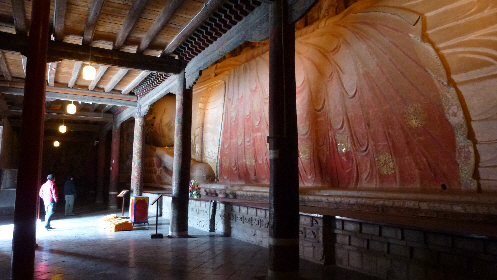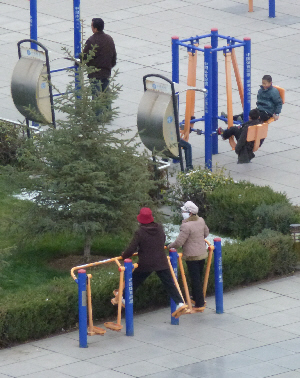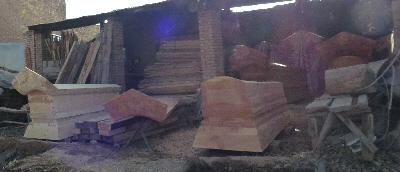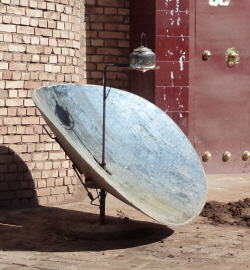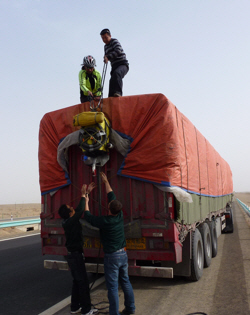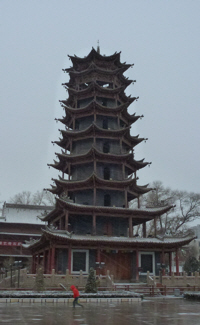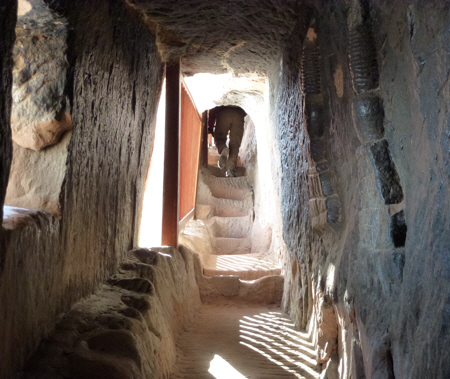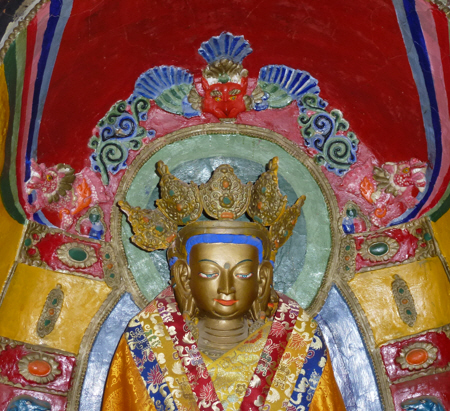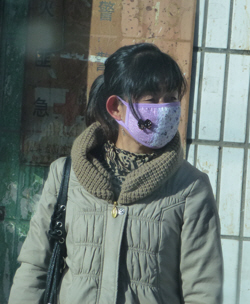Please accept our apologies for the lateness of this blog post. Our excuse is that whilst in Zhangye we decided (for a number of reasons) to take a break from pedalling once we reached Chengdu and spend some time back in the UK (where we’ve been a bit busy). So the day after our trip to the monastery at Mati Si, as Team Oz remounted their tandem and began pedalling, we retired to our hotel room to research and book flights home.
We’d barely begun this task when French Michael arrived having cycled through sand and snow storms all the way from when we’d last seen him (unlike Team Oz and Team UK who’d covered several hundred km in the warmth of a trucker’s cab). So after we’d sorted our flights we met up with him and went to see the Giant Buddha Temple in Zhangye which contains the largest reclining Buddha statue in China.
Having made the decision to pause our travels we now had a real deadline to aim for: our flight from Chengdu back to the UK (via Beijing and Moscow). And we wanted to arrive in Chengdu a few days before the flight to spend some time with my (Tamar’s) brother, Duncan, who lives there. A quick check of distances showed that despite our earlier ride on a truck it remained a pretty tall order to achieve that under our own steam, so it was back to hitching.
From Zhangye to Lanzhou we were still following the tedious G30 highway so we decided that would be a good section to cover on a truck, but for the first couple of days no-one wanted to stop for us. We hung around service stations and asked every likely looking truck driver, but to no avail, so in the end we just kept pedalling.
The weather continued to be cold with sub-zero nights and day time temperatures struggling to reach double figures, even when the sun was shining. We have a number of coping strategies for cold weather pedalling – unsurprisingly mostly involving more layers of clothes – but hands are always hard to keep toasty. Keith has a particular difficulty as thick gloves compromise gear selection and braking finesse, but for the princely sum of 20 Yuan (£2) a solution was found when he bought some handle-bar covers (seen on many mopeds and motorbikes) and these worked brilliantly, keeping his hands warm without resorting to gloves even on cold descents. Embarrassingly, the covers that fitted the bike the best had a nauseatingly twee ‘Strawberry Shortcake’ logo on them, which of course turned out to be the only thing we own that is impervious to dust and dirt.
Other adaptations to the cold weather include porridge for breakfast (with chopped apples and bananas, juicy raisins, and a generous dollop of honey: mmm-mmm!) and a revised routine in the evenings when setting up camp. We would ride until dusk and then pull off the road to look for a suitable campsite. As soon as we stopped, instead of inspecting the ground for the best possible place for the tent we would go straight to our panniers and layer up before our bodies realised we’d stopped moving and begun to cool down. I’d put on my waterproof trousers (over my normal trousers and thermal tights), my down jacket (hood up, over my 2 merino base-layers and a fleece), and then, if I wasn’t already wearing them, my gloves, hats, scarf and waterproof jacket. Then we’d select the campsite and put the tent up. Our gear was slung quickly into the tent and I’d have a final pee and leap into the tent too, donning my down booties before getting into the silk liner and sleeping bag. Then, and only then, would I consider chopping vegetables for dinner. I wouldn’t exit my sleeping bag until the sun had risen the next morning and the tent had begun to thaw out a bit. Keith is somewhat hardier and remained in the vestibule (having added only his down jacket to his attire) to cook dinner.
We’d been having trouble with our multi-fuel burner for several nights that a thorough cleaning did nothing to resolve, so after Zhangye we switched back to gas (we found a shop selling large canisters in Zhangye) which meant we could cook inside with the doors closed (vents open though). This kept the worst of the cold out, but did mean we got rather a lot of condensation inside the tent which then froze overnight.
After three days of failing to hitch a lift, we passed through the town of Wuwei and had a text from Ash and Laura to say there was a 3000m pass about 45 km down the road. This news encouraged us to put a bit more effort into getting a lift. The first van to stop for us turned out to be a local delivery man who couldn’t help us with a lift, but who could help us by generously presenting us with 20 large pastries (10 sweet and 10 savoury) that we had to strap on the side of the bike as they wouldn’t fit in our bags. The pastries were still warm and much appreciated as a few light flakes of snow began to fall around us.
In and around Wuwei we also saw people lighting small fires at the side of the road or, if they were able to, at gravesides, apparently burning fake money presumably as an offering to ancestors.
Despite our best efforts to hitch a lift, we were still travelling under our own steam when we arrived at the toll gate marking the start of the climb. We stopped just after the toll gate determined not to move until we got a lift. Truck after truck trundled by, but they either had no room for passengers, or simply chose not to stop. After about 40 cold minutes a van driver finally took pity on us and told us they could take us all the way to Lanzhou (about 250km). Perfect! Bike and bags were piled into the back of the van on top of tins of paint, a load of cabbages and a tractor tyre, but there was only room for one more in the cab. Keith offered to ride in the back, but as I am quite shy I insisted that he ride in the front and practice his Chinese whilst I perched on the tractor tyre in darkness and pretended to be a fugitive.
After a couple of hours we stopped for a late lunch of noodles, which we tried to pay for, but which the drivers insisted on buying for us instead, which was incredibly nice of them but rather frustrating for us as we really wanted to buy for them to say thanks for the lift. At around 4.30pm they dropped us off on the northern edge of the city of Lanzhou and we decided to use the remaining hour or so of daylight to get through the city and look for somewhere to camp on the 212 road going south out of the city. However, had we known about the extensive urban sprawl of Lanzhou and the long ascent to the south of the city we may have revised this plan, but based on the scant information on our map it had seemed like a reasonable plan.
As night fell we were still pedalling slowly upwards past shops and houses with no suitable camping spots in sight. Every corner or false summit brought the hope that we’d finally left the houses behind and would be into countryside, and time and again our hopes were crushed. Eventually, in desperation, we camped in a small quarry between two houses. It wasn’t ideal, but we were sufficiently hidden from the road to enjoy a reasonable night’s sleep and no-one disturbed us.
The next morning we continued climbing and although the air was cold we were soon sweating freely (which meant we got really cold every time we stopped for a break). At a height of about 2200m the tarmac ended at a work-site at the entrance to a tunnel, and a dirt-trail continued up to the right taking traffic over the mountain. Not fancying further climbing, especially on an unsurfaced, muddy road, we asked the workers which was the best way to go, and to our delight they let us ride through the tunnel (to the bemusement of their colleagues working inside the tunnel).
Descending on the other side we began to feel that we’d reached another distinct stage in our journey. After 2000+km we’d finally left behind the tedious G30 highway and with it the Taklamakan desert. Instead of the occasional village oasis surrounded by acres of empty, barren gravel, we found ourselves in a flat, fertile plain, which even at the tail end of the season was still bursting with cabbages, lettuces, beans, corn and a host of other vegetables.
We passed through village after bustling village, which added some much welcome interest and variety to our days, but did bring a few concerns about where on earth we were going to camp. To our surprise we suddenly found ourselves missing the emptiness of the desert.
The long fertile valley rose gently over the next day’s riding until we found ourselves up at almost 3000m again. The terrain after this continued to be hilly (much more so than we’d expected as there was no topographical representation on our map).
The road rose and fell and we found ourselves regularly up at around 2500m, before descending to 1500 only to have to climb it all again. But finally, on the fourth day after leaving Lanzhou, we had a day with hardly any climbing. A long gentle descent saw us do 155km in one day to reach Longnan where we treated ourselves to a night in a hotel.
South of Longnan the G212 road (which at times is confusingly called the G103 instead) takes a lengthy detour west, so we decided to take a short cut on the S206, saving ourselves 120km and a day’s worth of riding – or so we hoped. From looking at the riverlines on the map we’d guessed there’d be more climbing involved (although hadn’t figured it would be 1000m in 25km) but where our plans really went awry was the descent. Instead of 100km of smooth, easy descending and a similarly high-mileage day to the one into Longnan, we had 30km of tarmac and then 70km of rocks, mud and dust, which saw us crawling along at 8-10kph and saved us no time at all – especially as we were delayed for nearly an hour whilst workmen blasted some inconveniently placed cliffs out of their way.
We’d initially thought the bad condition of the road was because the G75 dual carriageway is being extended through the valley and it’s currently just one big worksite, but on closer inspection we reckoned that the road had never been asphalted even before the G75 work began.
The scenery was stunning though. The road wound through steep-sided mountains that twisted and interlocked, reminding me of the convoluted cortex of the brain, packing the maximum surface area into the smallest space. Villagers farmed vertically on narrow serried terraces, and finding somewhere to put the tent was near impossible. After riding in the dark for an hour we eventually pitched on a blocked-off weighbridge immediately adjacent to the road and had a somewhat disturbed night with lorries trundling past less than a metre from the walls of the tent.
China is developing its road network at an astonishing rate. All across the country roads are being upgraded to motorways, and geography and local residents are no bar to progress. Where the 206 road winds its way precariously up and down the mountains, the G75 takes the more direct approach of ploughing straight through them. Setting aside considerations of the impact on the environment and the villagers we couldn’t help but be impressed by the boldness and ambition of the engineering project. For hundreds of kilometres the new road alternately tunnels through mountains and soars on pillars above the narrow river at the bottom of a steep-sided valley. The scenery is dramatic and somehow the dramatic road fits in – or at least has the potential to once it stops looking like a worksite. In either case it’ll be an incredible road to drive when it’s finished.
After the slow progress on the S206 we knew we’d need to put in some really big days if we were to reach Chengdu in time to spend a few days with my brother before our flights home, but to our frustration, the terrain continued to be hillier than we’d anticipated. What looked on the map to be a day of following a river gently downhill, turned out to be a day of riding around the edge of a large lake formed by a dam and hydro-electric station. And don’t think this was a nice round lake: the steep hills were still crushed together tightly so the lake formed a series of fingers running up each valley and our route was a series of lengthy ins and outs along each finger, and of course the road had to go up and down too. We ascended over 1000m that day. And again, camping opportunities were few and far between.
Past the lake we found ourselves in a densely populated area where the towns just ran into each other and we resorted to camping in an abandoned hut next to a busy road and a pig farm, below a motorway flyover, on the edge of a city. It wasn’t the most peaceful evening, but at least we were hidden from view.

The morning after a surprisingly pleasant night in what had at first been a rather unappealing ‘last resort’ camping spot.
On the day we wanted to arrive in Chengdu we were still a good 250km away, and the hilly terrain showed little sign of flattening out, so it was back to hitching. We waited at the sliproad onto the motorway and after about 30 minutes a suitable truck stopped. This time there was room for both of us in the cab, and as before, despite our best efforts, when we stopped for lunch our driver wouldn’t let us pay.
Chengdu is easily the largest Chinese city we’ve been to (14 million inhabitants) and it’s still growing, both upwards and outwards.
Our truck dropped us off on the south side of the city near the impressive exhibition centre, and we made our way north east to the university where Duncan lives and works. New roads are springing up (literally in the case of the 2nd ring-road, the capacity of which is being increased by building a new road on pillars above the original road) all over the place so navigating was not necessarily straight forward, but we got to Dunk’s just fine and then, with his guidance, made the return journey south (via a pub) to his good friends Matt and Apple’s place, where we’d be staying. (Thanks Matt and Apple – you’ve been brilliant).
After the weeks of constant travel it was lovely to have a few days relaxing in one place. We went to visit the pandas, bought a cheap tablet computer (with the assistance of Dunk’s friend Pat -thanks Pat), got drunk and filled our stomachs regularly. Chengdu has great variety of restaurants. We’ve eaten Middle Eastern dishes (thank you Aimee), tasty Tibetan fare (yak meat featured heavily and was delicious) and enjoyed local delicacies of mutton soup, barbecued pig’s brains (surprisingly good if you hold your imagination at bay) and ‘thousand year eggs’ which are raw eggs preserved in a mixture of clay, ash, salt, quicklime, and rice hulls for several weeks to several months, depending on the method of processing. The alkalinity of this mixture slowly solidifies the inside of the egg until it takes on the consistency of a hard-boiled egg, but the white becomes colourless (and eventually turns a translucent brown if left in the clay mixture for longer), and the yolk ranges from a yellow colour to a dark greeny-blue depending on how long they’ve been preserved for.
All too soon it was time to pack our bags. We’ve left the bike and our baggage with Matt and Apple and borrowed a couple of rucksacks to carry our clothes and a few other bits and pieces. We’ll be in the UK for about 7 weeks, returning to China at the end of January 2013 to resume pedalling and blogging.
Hopefully the break will do us good. Whilst we’ve enjoyed many of our Chinese experiences we’ve found it quite a stressful place at times.
We want our memories of China to be dominated by all the lovely people who’ve waved, smiled and giggled as we’ve trundled by; the people who’ve given us lifts, helped us find hotels, paid for our meals, given us food, paid for our bus fare, helped us to order food and generally been lovely. However, when spending 6-7 hours a day on the road, the behaviour of drivers tends to feature disproportionately in your opinion of a place, and we’ve really struggled to enjoy Chinese roads…I’ll let Keith explain:
It’s no good – I’m not sure I can take this anymore. In the seven weeks since we’ve arrived in China at Kashgar, the horn hooting has just about got the better of me and I believe I would get a considerable amount of satisfaction by taking one of the blasting things and shoving it right up where the ‘sun don’t shine’. Coach and bus drivers are the worst for sure, but it seems to matter not a jot what you are driving as to the amount you use your horn at all other road users, especially those that are travelling slower than you. So if you just want to travel quickly along a road, you just blare your horn the whole way along the road, it’s that simple. Obviously the size of the noise should be related to the size of the vehicle, so lots of people have fitted extra loud horns to their somewhat smaller than coach-size 3-wheeled trucks. It’s not so bad when you just get a polite ‘toot-toot’ when the approaching vehicle is still 200 metres behind you, but some leave the sharp parp of their air-horn right up until the last minute, just when they are on your shoulder, and it just splits your ear-drum into two. Then there are those (and quite a lot of them exist – from coach drivers to just motorbike riders) who believe that their best policy is that as soon as anything comes into sight that is using their road (either side – doesn’t matter) simply putting one’s hand on the turbo-boosted twin air-horn and holding it there until the offender is a mere dot in their rear-view mirror, should ensure safe passage. We have even seen a couple of cars with (we believe) fake blue-&-red police-car type flashing lights behind the grill and having those flashing while blaring your horn, is also a good trick for clearing the way ahead. There are quite a few cars as well, with mock police sirens – that’s a good trick too. But now, I have actually asked Tamar in advance, for forgiveness, for the day that I actually stop in the middle of the road and block the blasted tooter … that’ll solve the problem for sure … or perhaps not.
Advance forgiveness has not been granted.
So that’s all from China for now (apart from a few additional photos for your enjoyment). Merry Christmas everyone and thanks for reading. Expect our next post sometime in February.

Fields are built perfectly level with a small ridge around the edge and are flooded periodically to irrigate them.

Animals made from blown sugar….like glass blowing but with sugar….and having seen them being made we’re not sure we’d want to eat them.
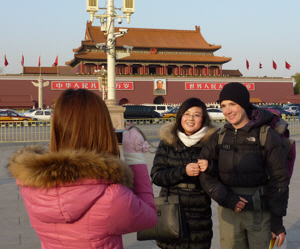
We flew home via Beijing, and even without the bike were still the centre of attention. In Tiananmen Square total strangers wanted their photos taken with us. Must be our natural charm and charisma.


